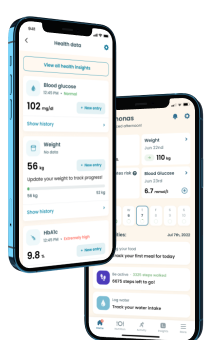Identifying Whole Foods in a Supermarket

Let’s face it, diabetes can be a big deal. Managing your diabetes – eating well, exercising, maintaining a good relationship with your doctor – is a big deal. Eating whole foods, a big deal. Finding whole foods? Not a big deal!
What We All Know: Whole Foods Are Good For You
Without even diving into the science, you and I both know whole, unprocessed foods are good for you. A fresh baked loaf of bread fresh from your oven is better than that spongey, white stuff that comes wrapped in the shape of a brick from the store. An apple off a tree is better than one that comes out of a can. This is simple, but what isn’t so simple or easy is finding whole foods in a store packed with junk food.
What Foods Are Whole Foods?
Many definitions of “whole foods” exist. Go ahead and Google it for yourself. You’ll see terms like “organic”, “natural”, and “clean” all used to describe $45 quinoa and hand-rolled oats from a village in a small Eastern European mountain town. If it comes from the ground, and looks like it is in it’s most natural form, that is a safe bet.
Many grocery stores have been carving out “health food” sections dedicated to providing you with the best, “most natural” products for your personal consumption. These foods typically come with green packaging, seals of approval from fancy organizations, and a much higher price tag. But are these foods really whole foods?
How to Find Whole Foods Grocery Shopping
Deciding if a food is whole or not comes done to simplicity. How much was it touched, how much was added to the product, how far did this food travel. Changing the way you shop is an easy effective way to surround yourself with real, whole, healthy food.
Load up on Staples
The simplest items on your shopping list are what you should be loading up on if you’re trying to stick to wholesome food. Butter, eggs, milk, rice, flour, yogurt, sugar – shop like a pioneer! These foods are used in almost every recipe and buying higher quality versions of these foods will make everyone of your dishes healthier and tastier.
Stick to the Produce Section
Eat cheap and well. The produce section at your local market is where you can find all the good stuff. Avoid snack aisles, avoid the freezer, and avoid the cans. Try to buy the majority of your items in the fruit and veggie section and you can’t really go wrong.
The produce may not be local, organic, or even the highest quality, but it still beats anything prepackaged.
Get to Know Your Butcher
Why buy pre-wrapped meat that you have no idea where it came from and how far it has traveled?
Most supermarkets have a butcher section that purchases bulk cuts of meat and portion down to size right there in the store. Many even buy semi-local since it’s often cheaper than shipping it. Plus, less preservatives are needed to keep a large hunk of meat since there is less surface area exposed to air.



Once you get familiar with your butcher, they’ll let you know what cuts are the good stuff.
Learn to Hate Packaging
Anything put in a package is wrapped so it can extend its shelf life. How do you think food companies increase the shelf life of a product? Preservatives, more salt, dehydration – all of which create a less fresh product. Also, plastic is bad so try to stick to stuff you can touch.
Avoid Long Ingredient Lists
If you’re buying rice, just buy rice! Many flavoured rice offerings are stuffed with things other than rice. If you want something with a little more flavor invest in some good spice and brush up some easy spice combinations. This trick will force you to become a better cook and save you tons of money in the long run.
Avoiding complicated products will help you not only eat better but also when someone says they love whatever you’re cooking, you’ll know that was all you and no thanks will be given to Uncle Ben or Zatarans.
Go to Your Local Farmer’s Market
All of the previous tips can be thrown out if you decide to do your shopping at a farmers market. Food at farmer markets is literally driven from the farm to the stall that morning. You can’t get anything fresher.
Spend some time talking to the people that grow your food. Often, the sellers are super proud of their products and will give you the whole story of how they grow your veggies. They’ll even tell you the name of the chicken you just bought.
On top of that, most will share with you their favorite way of cooking and preparing what you just bought.
Often, seasonal eating can lead to us diversifying our intake, and it is often cheaper, too. You can identify seasonal foods by seeing what is on sale at the grocery store or what is available in abundance during certain times of the year (like watermelon in the summer or pumpkin/squash in the fall).
Keep It Simple.
Focus on foods that have been the least touched by human hands. The closer your food is from the ground it was grown or raised on the more nutritious, more delicious, and more “whole” it is.
Keeping it simple will make a difference in how you feel each day. Keeping it simple will make you a more informed cook, help you better get to know your community, and save you tons of cash in the long run. Keeping it simple is the first step you need to take in order to better manage your diabetes and making it not such a big deal.
Take a quiz and get your diabetes-management plan today!








